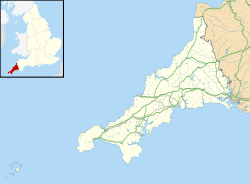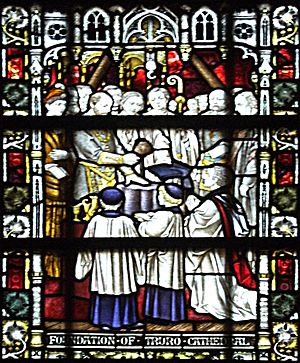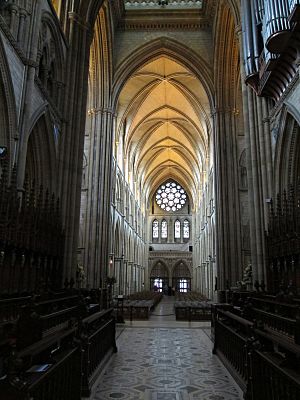Truro Cathedral facts for kids
Quick facts for kids Truro Cathedral |
|
|---|---|
| Cathedral Church of the Blessed Virgin Mary | |
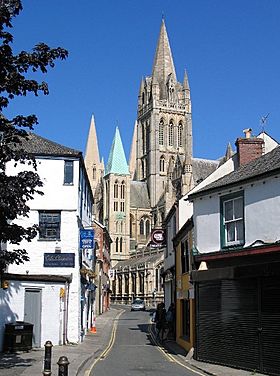 |
|
| 50°15′51″N 05°03′04″W / 50.26417°N 5.05111°W | |
| Location | Truro, Cornwall |
| Country | United Kingdom |
| Denomination | Church of England |
| Tradition | High Church |
| Website | www.trurocathedral.org.uk |
| History | |
| Former name(s) | The Parish Church of St Mary's, Truro |
| Consecrated | 1887 |
| Architecture | |
| Architect(s) | J. L. Pearson |
| Style | Gothic Revival |
| Years built | 1880–1910 |
| Specifications | |
| Number of towers | 4 |
| Number of spires | 3 |
| Spire height | 76m (crossing), 61m (western) |
| Administration | |
| Diocese | Truro (since 1876) |
| Province | Canterbury |
The Cathedral of the Blessed Virgin Mary, often called Truro Cathedral, is a large church in the city of Truro, Cornwall. It belongs to the Church of England. This amazing building was constructed between 1880 and 1910. It was designed in a style called Gothic Revival by John Loughborough Pearson. Truro Cathedral is special because it's one of only three cathedrals in the United Kingdom that has three spires.
Contents
History of Truro Cathedral
The idea for a new church area, called the Diocese of Truro, started in December 1876. The first bishop, Edward White Benson, began his role in 1877.
Building the cathedral started in 1880. It was designed by a famous architect, John Loughborough Pearson. Truro Cathedral was the first Anglican cathedral built in a new spot in England since Salisbury Cathedral in 1220. It was built where an older church, St Mary the Virgin, used to stand. That old church was taken down in October 1880, but its south side was kept. This part is still used as a local church today.
For a few years, a temporary wooden building served as the main church. It was very basic, hot in summer and cold in winter. It was here, on Christmas Eve in 1880, that Bishop Benson started the tradition of the "Nine Lessons and Carols" service. This service is now famous worldwide.
The main parts of the cathedral, like the choir and transepts, were finished by 1887. A special service to make the building official happened on November 3, 1887. The central tower was completed by 1905. The whole cathedral, with its two western towers, was finally finished in 1910. J. L. Pearson, the original architect, passed away in 1897. His son, Frank, took over and completed the project.
Cathedral Design and Features
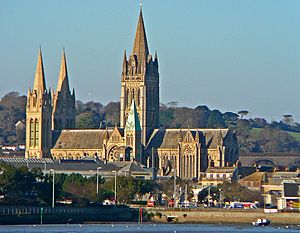
Pearson's design mixes English and French Gothic styles. It looks a bit like Lincoln Cathedral. The central tower and spire are about 76 meters (250 feet) tall. The western towers are about 61 meters (200 feet) tall. Different types of stone were used, including local granite and Bath stone. The spires are made of stone, and the other roofs are slate. The inside of the cathedral has beautiful vaulted ceilings.
The original south side of St Mary's Church is still part of the cathedral. It's called St Mary's Aisle and still works as a local parish church. The cathedral is named after the Blessed Virgin Mary. It has special chapels for quiet prayer, like the Jesus Chapel. For many years, there was no chapter house (a meeting room for the clergy). A new one was added in 1967.
In 1994, Queen Elizabeth II visited the cathedral for the Royal Maundy Service. She gave special coins, called Maundy money, to 134 Cornish people.
Restoring the Cathedral
In 2002, the cathedral started a big project to fix and restore parts of the building. This included the east end, the west front, and the central tower and spire. This work is done in stages as money becomes available.
The restoration fixes stonework and repairs damage to the stained glass windows. A big project in 2004 restored the large west front and its towers. Work on the central tower and spire began in 2009 and 2010.
The company doing the work, W. R. Bedford, explained that the Bath stone used on the decorative parts of the cathedral has been damaged by the salty air from the sea. This has made the stone look like a honeycomb. Money for the repairs comes from different groups, including English Heritage and the Heritage Lottery Fund. A special campaign called "Save Our Spire" has also raised a lot of money.
How the Cathedral is Run
The cathedral is managed by a group of people. This group includes the dean, who is the main leader, and other important clergy members called canons. They work together with a cathedral council.
Leaders of the Cathedral
As of October 2022, Simon Robinson is the interim Dean of Truro. He is expected to become the permanent dean soon. Other important roles include the Canon Chancellor and the Canon Precentor.
Cathedral Organs
The main organ in Truro Cathedral was built in 1887 by Father Willis. It is considered one of the best organs in the country. It was built in London and brought to Cornwall by boat.
The organ was mostly unchanged until 1963. At that time, it was carefully restored. The organ's control panel, called the console, was moved. It used to be high up inside the organ, making it hard for the organist to hear the music properly or see the choir. In 1963, the console was moved to a new spot above the choir stalls. This helps the organist hear better and work closely with the choir.
There is also another organ in St Mary's Aisle. This smaller organ is the only part left from the old parish church. It was originally built in 1750.
In 2012, famous lyricist Tim Rice helped raise money for the cathedral's choir and music.
Organists of Truro Cathedral
Many talented musicians have served as organists at Truro Cathedral. They lead the music for services.
Organist and Master of the Choristers
- 1876 William Mitchell
- 1881 George Robertson Sinclair
- 1890 Mark James Monk
- 1920 Hubert Stanley Middleton
- 1926 John Dykes Bower
- 1929 Guillaume Ormond
- 1971 John Charles Winter
- 1989 David Briggs
- 1994 Andrew Nethsingha
- 2002 Robert Sharpe
- 2008 Christopher Gray
- 2023 James Anderson-Besant
Assistant Organists
- Ivor Atkins 1885–1886
- Frederick Rowland Tims 1902–1907
- William Stanley Sutton 1907–1911
- Mr Hall 1911
- Donald Behenna
- Gerald Hocken Knight 1922–1926
- Arthur William Baines
- John Charles Winter 1950 – 1971
- Henry Doughty 1971–1991
- Simon Morley 1991–2000
- Christopher Gray 2000–2008
- Luke Bond 2008–2017
- Joseph Wicks 2017–2019
- Andrew Wyatt 2019–
Organ Scholars
- Luke Bond 1998–1999
- Christopher Teel 1999–2000
- Andrew Senn 2000–2001
- Nicholas Wearne 2001–2002
- Michael Phillips 2002
- Tom Wilkinson 2003–2004
- Claire Cousens 2004–2005
- Tom Little 2005–2006
- David Moore 2006–2007
- Shiloh Roby 2007–2008
- Joshua Hales 2008–2009
- Donald Hunt 2009–2010
- Sachin Gunga 2010–2011
- Edward Symington 2011–2012
- Harry Meehan 2012–2013
- Rachel Mahon 2013–2014
- James Orford 2014–2015
- Joseph O’Berry 2015–2016
- Käthe Wright Kaufman 2016–2017
- William Fairbairn 2017–2018
- Carolyn Craig 2018–2019
- Manuel Piazza 2019–2020
- Alden Wright 2021–2022
- Tom Dilley 2022–2023
- Jeremiah Mead 2023–2024
Cathedral Bells
The cathedral has a set of ten bells that were made in 1909. Four more bells were added in 2011. Two of these completed the main set to twelve bells. The other two are smaller, offering a lighter sound. There are also six older bells in the Green Tower. These bells were originally from St Mary's Parish Church.
The Cathedral Choir
Truro Cathedral has a long tradition of choral music, going back to 1876. Today, the choir has twelve adult singers. They are joined by eighteen boy choristers or eighteen girl choristers. The choristers attend Truro School.
Girl choristers joined the cathedral choir for the first time in 2015. In 2017, they made history by appearing on a BBC Radio 3 show called Choral Evensong. They were also chosen to sing at the coronation of Charles III and Camilla in 2023.
The choir even appeared on the TV show Britain's Got Talent in 2019!
Images for kids
See also
 In Spanish: Catedral de Truro para niños
In Spanish: Catedral de Truro para niños
- List of cathedrals in the United Kingdom
- List of topics related to Cornwall
- List of new ecclesiastical buildings by J. L. Pearson


